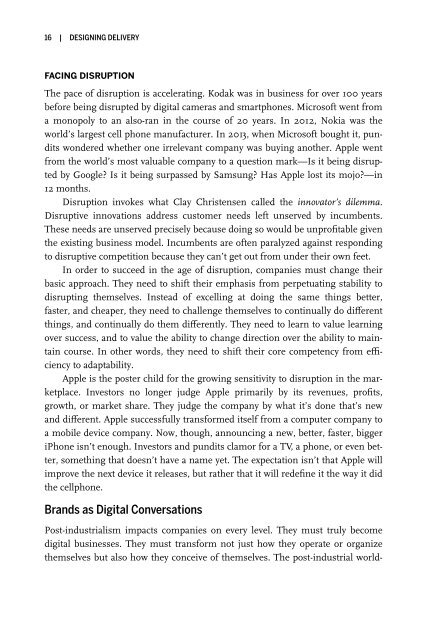Designing Delivery
1Tox6aC
1Tox6aC
Create successful ePaper yourself
Turn your PDF publications into a flip-book with our unique Google optimized e-Paper software.
16 | DESIGNING DELIVERY<br />
FACING DISRUPTION<br />
The pace of disruption is accelerating. Kodak was in business for over 100 years<br />
before being disrupted by digital cameras and smartphones. Microsoft went from<br />
a monopoly to an also-ran in the course of 20 years. In 2012, Nokia was the<br />
world’s largest cell phone manufacturer. In 2013, when Microsoft bought it, pundits<br />
wondered whether one irrelevant company was buying another. Apple went<br />
from the world’s most valuable company to a question mark—Is it being disrupted<br />
by Google? Is it being surpassed by Samsung? Has Apple lost its mojo?—in<br />
12 months.<br />
Disruption invokes what Clay Christensen called the innovator’s dilemma.<br />
Disruptive innovations address customer needs left unserved by incumbents.<br />
These needs are unserved precisely because doing so would be unprofitable given<br />
the existing business model. Incumbents are often paralyzed against responding<br />
to disruptive competition because they can’t get out from under their own feet.<br />
In order to succeed in the age of disruption, companies must change their<br />
basic approach. They need to shift their emphasis from perpetuating stability to<br />
disrupting themselves. Instead of excelling at doing the same things better,<br />
faster, and cheaper, they need to challenge themselves to continually do different<br />
things, and continually do them differently. They need to learn to value learning<br />
over success, and to value the ability to change direction over the ability to maintain<br />
course. In other words, they need to shift their core competency from efficiency<br />
to adaptability.<br />
Apple is the poster child for the growing sensitivity to disruption in the marketplace.<br />
Investors no longer judge Apple primarily by its revenues, profits,<br />
growth, or market share. They judge the company by what it’s done that’s new<br />
and different. Apple successfully transformed itself from a computer company to<br />
a mobile device company. Now, though, announcing a new, better, faster, bigger<br />
iPhone isn’t enough. Investors and pundits clamor for a TV, a phone, or even better,<br />
something that doesn’t have a name yet. The expectation isn’t that Apple will<br />
improve the next device it releases, but rather that it will redefine it the way it did<br />
the cellphone.<br />
Brands as Digital Conversations<br />
Post-industrialism impacts companies on every level. They must truly become<br />
digital businesses. They must transform not just how they operate or organize<br />
themselves but also how they conceive of themselves. The post-industrial world-


